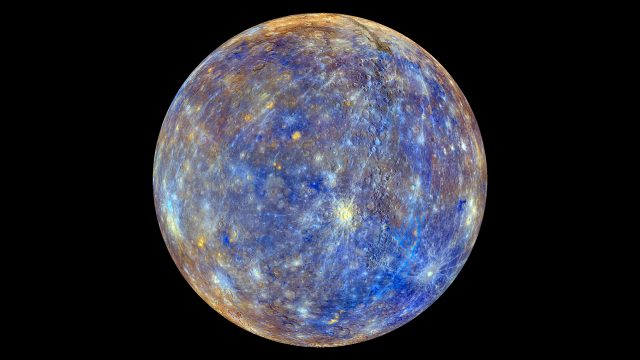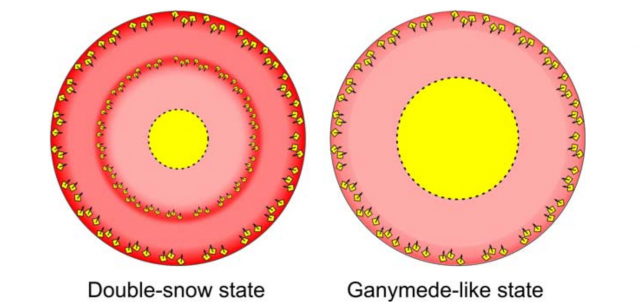Mercury’s magnetic puzzle
Is it possible to have an asymmetric magnetic field when all boundary conditions are known to be symmetric? The question seems awkward but the counter-intuitive reality is always there to make Science far more interesting, as revealed recently by Hao Cao and collaborators 1. Today’s story is a good combination of intriguing observations and amazing numerical models, all covered with some iron snow.

MESSENGER spacecraft is a mission envisioned by NASA to orbit Mercury for the first time. Its name stands for MErcury Surface, Space Environment, Geochemistry and Ranging, while Mercury/Hermes was the gods’ messenger in classical mythology. This ambitious mission was designed to also flyby Earth and Venus and to acquire data that help to understand these planets before entering the nominal mission around the first planet of our system.
Among the spacecraft payload, there are some instruments designed to measure the magnetic field of the planet, being able to separate the internal and external field contributions. Previous Mariner 10 flybys had shown the magnetic field to be weaker than the Earth’s field and mostly dipole-like. But some surprises were waiting to be discovered. While the general picture was correct, the magnetic equator is actually displaced some 500km northwards of the geographic equator (the radius of the planet is less than 2500 km) and the magnetic field was three times stronger in the Northern than in the Southern Hemisphere 2. This created a new category for planetary magnetic fields, opposed to the symmetric dipoles (Earth, Jupiter and Saturn) and non-axial multipoles (Uranus and Neptune). This made Mercury truly one of a kind, and a good object of desire for scientists.
Very interestingly, most of what we can see from the outside is roughly symmetrical in Mercury. At this point we do not have seismological data from the planet’s interior so there is no experimental clue on how the heart of the dynamo (i.e. the planet’s core, accounting for about 85% of the planetary radius) is behaving. But we can gain some insight by investigating the properties of the expected mix of iron of sulfur at high pressure. When this was done in 2008 by Bin Chen and collaborators 3, another surprise was revealed: Iron could be precipitating in Mercury’s interior, in the form of snow, possibly in one or two layers around the solid interior. And this must have an impact on the planet’s magnetic field that must be addressed by any model pretending to reproduce observations.

In this context, the work by Cao and collaborators has provided a modeling framework to explain these observations all together. They were able to generate stable asymmetric magnetic field for Mercury even with symmetrical thermal boundaries. For doing so, they used a numerical dynamo model with a number of assumptions. Basically, they played with two different buoyancy sources, either distributed along the whole volume (volumetric buoyancy, VB) or bottom driven (BD). The results of the simulations unambiguously showed that volumetric buoyancy was able to reproduce the asymmetric magnetic field of Mercury in a stable way. This kind of distribution of buoyancy sources is well correlated with the double iron snow model proposed by Chen et al., thus providing a solid ground for this model to be accepted.

However, another ingredient was required. The heat flow at the core-mantle boundary (CMB) provided the last component for the symmetry breaking the model was looking for. While in Mars there are some clues of an asymmetric lower mantle temperature heterogeneity, this seems not to be the case for Mercury’s thin mantle, in spite of the largest hemispheric asymmetry in the planet caused by the Caloris impact, whose effect should have decayed fastly a long time ago. However, MESSENGER mission has suggested that the equatorial regions have a crust thicker than other latitudes, maybe the proof of a greater upwelling at the equatorial zones. Is this symmetric anomaly enough to sustain an asymmetric magnetic field? According to Cao’s work, it is. The interaction between even and odd modes of columnar convection are able to produce a mixed mode with enhanced flow in one of the hemispheres. The model has no preference for one hemisphere or the other but, once the symmetry is broken, the magnetic field continues to be asymmetric as long as the simulations go.
This picture of Mercury’s interior seems to be quite robust. Simulations and model support the puzzling observations. But there is still a long way to the complete understanding of the planet. As Cao and collaborators point out “Gravity, topography, temperature and heat flow measurements from future missions (e.g., Bepi Colombo) will further advance our understanding of Mercury’s manle and core […]”. It is certainly exciting, since dynamos support most of planetary magnetic fields we know so far, to know which ingredients make the recipe for a stable magnetic field, which is sometimes pointed out as one key aspect for finding a twin Earth around other stars. In any case, planets behave once again as natural laboratories in which we test our current ideas on geophysics, geochemistry and other fields. And this alone deserves further research.
References
- Cao H., Johannes Wicht, Wieland Dietrich, Krista M. Soderlund & Christopher T. Russell (2014). A dynamo explanation for Mercury’s anomalous magnetic field, Geophysical Research Letters, 41 (12) 4127-4134. DOI: http://dx.doi.org/10.1002/2014gl060196 ↩
- Brian J. Anderson et al. (2011). The global magnetic field of Mercury from MESSENGER orbital observations. Science 333, 1859, doi: 10.1126/science.1211001 ↩
- Bin Chen et al. (2008). Non-ideal liquidus curve in the Fe-S system and Mercury’s snowing core. Geophys. Res. Lett. 35, L07201, doi: 10.1029/2008GL033311 ↩
3 comments
[…] [Leer la entrada completa en Mapping Ignorance] Tweet […]
[…] y la respuesta tiene como componentes ordenadores y nieve de hierro (y no, no es una errata). Mercury’s magnetic puzzle por Santiago Pérez […]
[…] Planeta baten eremu magnetikoaren baitan eragina izan dezakeen guztiak simetrikoa badirudi ere, zergatik eremu magnetikoa bera ez da simetrikoa? Merkuriotaz ari gara, eta erantzunean ordenagailuek eta burdin elurrak (ez, ez da akatsa) badute zerikusia. Santiago Pérez Hoyosen Mercury´s magnetic […]